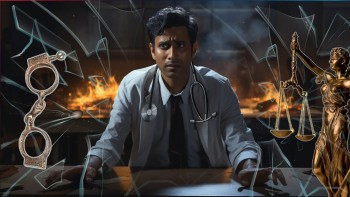Brief History of the case-
On 04.02.2012, a young practicing physician (since deceased –hereinafter referred to as the ‘patient’) consulted the Gynaecologist - Dr. A (hereinafter referred to as the ‘OP-2’) for her pelvic pain during menses. As prescribed, she took Oral Contraceptive Pills from July, 2012 to March, 2013, got relief for that period and then the medicines were stopped. Again on 19.03.2013, she developed pain and consulted the OP- 2, who advised ‘D & C’ laparoscopic Dye Test. As it was an invasive procedure, the patient did not agree for the test. However, during subsequent visits on 30.04.2013, 31.10.2013 and 22.02.2014, the OP-2 insisted for the test. Therefore, the patient agreed and the test was fixed to be done on 05.03.2014 in a tertiary care Centre (OP- 1). It was alleged that on 05.03.2014, the procedure commenced at about 9.50 am, however within 15 minutes of its commencement, Dr. A informed the patient’s husband (Complainant No. 1) that the patient suffered a massive Cardiac Arrest and no hope of survival. At 11.15 am, the patient was shifted to ICU, but while shifting, the patient’s attendants did not notice any signs of life. It was alleged that the patient was pretentiously taken to ICU to give false impression of continuing treatment. The patient was declared dead at about 1.30 p.m. The Complainants alleged that the death was due to gross medical negligence of the Hospital and the OP- 2. The Complainant lodged an FIR before local Police Station registered U/S 304A/34 of IPC. The post mortem examination was done which prima facie revealed cause of death being surgical procedure. According to the Complainants, it was a case of res-ipsa loquitur. The patient’s husband, after the incident, took opinion of few expert doctors, which revealed gross negligence of the OP- 2. He was lacking skill to perform D & C Laparoscopic Dye Test and performed the procedure even though the patient was not willing.
Post mortem- PM revealed perforation of small Intestine and the final opinion that death was due to effect of surgical procedure while the cause of death mentioned by Hospital was anaphylaxis or embolism followed by cardiac arrest.
Complaints:
Family of the deceased lodged complaint in SMC,in NCDRC and a FIR was also lodged under section 304A of IPC in the local PS
Allegations made in the NCDRC –
It was alleged that
01. The surgeon failed in his duty of care and caused bowel injury to the patient, which went unnoticed. 02.The video recording of the procedure was not done.
03. Negligence per se of Anaesthetist( OP- 3) was also there who failed to do pre-aesthetic check-up (PAC).
04. As per anaesthesia prescription, no pre-operative medicines (sedatives) were given and anaesthesia chart shows interpolation, it was not maintained properly. The OP- 3 administered anaesthesia without safety measures like multi-channel monitors
05. The procedure was done without Capnograph machine.
06. The OPs- 2 to 8(All doctors and OT staff) were also negligent, who failed to detect the deteriorating condition of the patient and failed to revive her during cardiac arrest due to lack of emergency equipment in the operation theatre.
07. The endometrial tissue was not sent for histopathology and the hospital stated that it was misplaced.
All members of the operating team -Gynecologist, Anesthetist, OT technician, OT nurse, Sr registrar, the cardiologist who assisted in CPR and the hospital were made the party.
Complainant produced expert opinion of a senior Gynecologist. He concluded the following deficiencies:
1. Surgeon has committed an error as it has caused perforation in small Intestine.
2. Anaesthetist has not-done any pre-anaesthetic check-up.
3. Dosages of Scoline were higher than recommended,
4. No monitoring of vitals "like pulse and BP was done during anaesthesia.
5. Patient’s Age and weight wrongly recorded.
6. No video record of procedure was done.
7. No recording of pulse oxymeter and Capnography.
8. Endometrium sample was lost by hospital showing gross negligence,
9. Timely detection of cardiac arrest was not done in proper time and hence caused death of patient.
The complainant asked 50 cr as compensation including 10 Cr from Hospital
Hospital and operating doctors denied the charges of any negligence.
The OP-1(Hospital) submitted that before the procedure, the on duty medical officer, examined the patient. As per the past history of the patient, in 2006, she underwent appendectomy under General Anaesthesia, therefore, she was deemed to have a good tolerance for the anaesthetic drugs. During the procedure, the patient was connected to multi-channel monitors. The patient was attended by three doctors, anaesthetists and nurses/paramedics. The OP- 1 further submitted that the D & C + Lap Dye Test was conducted successfully within about 15 minutes, but, subsequently the patient suffered sudden cardiac arrest. Immediately, blue code was alerted and resuscitative measures as per the standard protocol were performed, the patient was shifted to ICCU, but she could not survive.
The OP- 2 – ( Gynaecologist) submitted that initially the patient was diagnosed as repeated secondary dysmenorrhea. After investigations, she was prescribed oral contraceptive pills (OCP) and other medicines for the relief from her repeated pain. The patient responded well to the OCPs. Clinically, the OP- 2 suspected ‘Mittleschmerz’, but it was ruled out. The Ultrasonography (USG) revealed multiple myomas – i.e. benign tumors (fibroids) of uterus, adenomyosis and poly cystic ovarian syndrome (PCOD). Thereafter, in March 2013, the OP- 2 advised ‘Dilation & Curettage with Laparoscopic Dye Test’ to visualise the pelvic organs. On 03.03.2014 in morning, the laparoscopic procedure was started. After induction of anaesthesia, the pneumo-peritoneum was created smoothly with carbon-dioxide (CO2 ) by using verse needle via infra umbilical port. Subsequently, dye test was performed using vaginal cannula by injecting 20ml of distilled water coloured with approximately 3-4 drops of methylene blue. The procedure was completed with curettage of one strip of endometrium obtained. After 15 minutes of the completion of the procedure, the RMO informed about sudden deterioration of the condition of the patient. Immediately, the OP- 2 rushed to the O.T. The external cardiac massage and IV medications were started. The CPR team immediately rushed to O.T. and the CPR was continued. The senior Cardiologist, (OP- 8 in the instant case) was also called by the OP- 2. The patient was immediately transferred to the ICCU for ventilatory support with cardiac pacing. Despite all efforts from the entire medical team, the patient could not be revived and declared dead at around 01.25 p.m.
Decision of the State Medical Council was taken into consideration by NCDRC-
In reference to the allegations raised in the complaint, the SMC had made the following observations:
1. This procedure was justified in the instant case.
2. Employing the services of Anesthetist (not a regular member of that team) was not wrong as she was adequately qualified and vastly experienced.
3. Apart from the pre-operative examinations done, no other investigations were mandatory as the patient's condition did not call for any such investigations.
4. Lack of video recording of the operation could not be taken as a deficiency on the part of the medical practitioners since most Operation Theatres in the world do not have video monitoring. Besides this, it was not a mandatory provision.
5. Lack of video recording of the laparoscopy was also not a deficiency in the instant case as this was not a standard procedure.
6. Death on table could not be declared in the instant case since standard procedure demands at least 45 minutes of CPR to revive a patient. On that ground, temporary pacing was justified. The efforts on this ground by team involved in the management of the patient be appreciated since the patient was only 31 years old.
7. The surgeon was not in his regular cloths (he had taken off his gown and was in his ‘theatre green’ –as deposed by the witness) and he did enquire from anaesthetist if everything was OK before leaving the room when he opened his gown in front of the scrub basin and washed his hands. He was next to move the Surgeons’ lounge to write his notes when he was informed of the cardiac arrest.
8. The autopsy report indicated a small bowel perforation but that could not lead to such an extraordinarily rapid and sudden death. The patient, the committee feels was in profound hypotension for maybe 2 or 3 minutes, in between or after the last NIBP recording, in which period the tachycardia compensation did not occur or, sudden stimulus lead initially to an almost inexplicable brady and almost immediate cardiac arrest.
9. The Blue Code Team arrived as soon as possible and took over the patient but there was no loss of time as external massage was started instantaneously by the surgical team as per recommended CPR protocols. However, no single etiology could be attributed to this death and there might be several reasons leading to the failure of her revival.
10. Presence of a cardiologist in such type of surgical procedure was not mandatory and therefore, it was no fault on the part of the Operation Team to call for the assistance of the cardiologist when situation demanded.
11. The dosage of drugs administered was rational and no significant dosage error was evident. The patient was not given any drug, which was contra-indicated in her case.
12. The resuscitation procedure was initiated immediately by the Members of the surgical team, which was taken over by the Code Blue Team within reasonable time. The SMC concluded that the doctors involved in the instant case were not negligent. However, it pointed out deficiencies in the infrastructure of a Tertiary Care Hospital. The Council decided to write to the Director of Health Services, State Government to advise the concerned hospital authority to install recording facilities in the OT monitors so that retrieval of data for future examination could be made possible. It is pertinent to note that the ethics committee of MCI unanimously decided to exonerate the operating surgeon, the Anesthetist, and the Cardiologist.
It is pertinent to note that the SMC took an opinion from a retired Prof. & Head of the department of Anaesthesiology, at AIIMS, New Delhi. His opinion was based on the documents. He, after going through the records, and opinion given by the Forensic expert, opined the possibilities for cause of cardiac arrest as-
1. Anaphylactic shock to Methylene blue instillation (patient has history of allergy to certain drugs as elicited in history).
2. Gas embolism due to uncontrolled gas insufflations or direct injection of gas into an organ (small intestine perforation)or a blood vessel. (No mention made of insufflating pressure or use of an gas insufflator).
The verdict by NCDRC –
In the final verdict the commission mentioned that-The SMC and the opinion of experts affirmed that pre-operative anaesthetic check-up was duly conducted and nothing was abnormal. The D&C-Laparoscopic procedure was also uneventful but after the procedure, the patient had a cardiac arrest on the operation table. All the resuscitative measures were taken but unfortunately could not save the life. The PM was performed, but the Autopsy Surgeon could not confirm the cause of death. The SMC noted that both the Gynecologist and the Anesthetist had long experience in their respective field of practice and there was no deficiency in the services rendered by them in the instant case.
However, the commission summed-up some of the patent lapses on the part of the Hospital Administration-
01.A few blank spaces were apparent in the Consent Form. Age and Weight of the patient were erroneously recorded.
02. Pre-anesthetic check-up was not done.
03.The specimen of endometrium was not sent for Histo-Pathology Examination (HPE), which was admitted by the hospital, as it was “lost” and hence not sent for HPE.
04. More importantly, Capnograph, as also proper Multi Channel Monitoring System of acceptable standard, were not available in the OT even though it was a Tertiary Care Hospital.
05. A most serious lapse was the association of the OP- 5 “Doctor” with the operation, who, it is an admitted and proved fact, was not qualified as a Doctor at all and had no medical degree whatsoever but was yet an integral part of the operating team of doctors. In fact she was employed with the OP-1(Hospital) as “Resident Registrar”. The very fact that a person masquerading as a Doctor was inside the OT with the approval and knowledge of the Hospital Administration speaks (most adversely) for itself and is per se an unfair and deceptive act within the meaning of ‘unfair trade practice’ under the Act 1986.
Compensation awarded:
While awarding the compensation the commission mentioned- “It is unfortunate that the deceased was a young doctor, a physician, aged just 31 years, who lost her precious life. This necessitates just and adequate compensation. There is no straight jacketed formula for award of compensation, it is difficult to quantify the value of human life in monetary terms, but considering the facts and circumstances, to attempt to meet the ends of justice, lumpsum compensation of Rs. 1.25 crore appears to be just and adequate in the present case. As such, we deem it appropriate that the OP-1 hospital shall pay Rs. 1.25 crore to the Complainants within 6 weeks from today, failing which the amount shall carry interest at the rate of 9% per annum till its realisation. Additionally, the OP- 1 hospital shall pay Rs. 2 lakh towards cost of litigation to the Complainants. We would also like to request the State Government of West Bengal through its Chief Secretary to get the OP-1 hospital inspected in order to ensure that it is compliant with the statutory requirements and licencing protocols.
| Key learning points from the case- | |
 |
Consent form must be filled very carefully |
 |
PAC is mandatory in all cases |
 |
Specimen of tissue should be carefully preserved with HPE report |
 |
OT should be well equipped with multipara monitors and Capnograph where Lap procedures are done |
 |
Unregistered doctors should not be hired for clinical duties |
Access the original order through this link- NCDRC decision











Recent comments
Latest Comments section by users